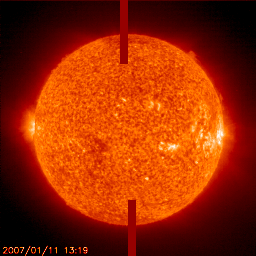Calculations
Here we outline the standard calculations involved to obtain the order of magnitude for the gravitational wave signal. Given two nearby test particles, such as those illustrated above in the animation, they will move in an oscillatory motion due to the influence of a passing gravitational wave.
The small change in the Newtonian gravitational potential (![]() ) comes readily by solving the equations of stellar pulsation. A Poisson equation arises for which the solution as presented by Cutler et. al. (1996) is
) comes readily by solving the equations of stellar pulsation. A Poisson equation arises for which the solution as presented by Cutler et. al. (1996) is
 |
(1) |
The relative acceleration between the two test particles arises from the Newtonian equation of deviation,
 |
(2) |
 |
(3) |
This order of magnitude calculation holds true for the LISA design as the test masses will always be nearby with respect to the distance from the solar source. Whereas for ASTROD, the satellites will not always be nearby and thus an order of magnitude is anticipated to be lost. Therefore, any decrease in ASTROD's orbital radius design will have a significant improvement of imminent detection of both gravitational waves and solar g-modes.
The movie of the sun as shown above was taken from http://sohowww.nasa.gov/data/LATEST/current_eit_304.mpg
Page last updated on 1 January, 1970
Latest News

